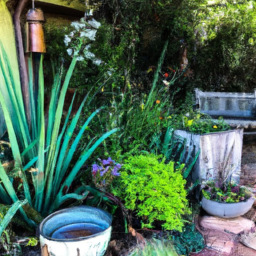Backyard Xeriscape Ideas
Table of Contents []
Backyard Xeriscape Ideas
Backyard Xeriscape Ideas to Transform Your Outdoor Space
Xeriscaping is the practice of creating gardens and landscapes that require the least amount of water and maintenance possible. There are many advantages to xeriscaping, including reducing water consumption and offering native plants as great alternatives to more traditional landscaping. Plus, it can help to reduce the amount of work that goes into landscaping maintenance. If you'd like to give xeriscaping a try, here are some wonderful backyard xeriscape ideas to get you started.
Choose Native Plant Species
Native plants are adapted to the local climate, so they require little watering and are often more successful in xeriscape unveilings. Infact, many traditional and exotic plants aren't as adapted to certain regions as native varieties. So, you must research your local climate before selecting any plants and plant species.
Maximize Shade
Shading the backyard is an effective way to conserve water and maintain cooler temperatures during the summer. Strategically placing trees, shrubs, and other large plants can increase the natural shade in your outdoor area. As no water is needed in the shade, that will reduce your overall water consumption significantly.
Create Raised Gardens
Raised gardens can be great for container gardening. Since the soil in a raised bed is not as porous as a regular soil, water loss from evaporation and drainage is significantly reduced. Additionally, herbs, flowers, and vegetables do really well in raised gardens in areas that are particularly wet or dry.
Introduce Boulders and Stones
If your backyard isn't very green, adding beautiful boulders and stones can give it a real xeriscape look. Boulders come in a range of sizes, shapes, and colors. They can be used to form pathways, add interest, and to block wind and sun. Medium-sized rocks can also be used to boundary or enclose specific beds and gardens.
Opt for Breezy Landscapes
Wind can have an effect on how much water evaporation you experience in your backyard. To keep the air moving, incorporate trees, fences, walls, or lattices into your xeriscape design. These design elements will contribute to the overall look and aesthetic of your backyard.
Opt for Low Maintenance Plants
When it comes to xeriscaping, low maintenance plants are key. You want to select hardy plants that can thrive in your local climate without any added fertilizers or pesticides. There are many varieties of low maintenance plants, from annuals and perennials to shrubs and trees.
Incorporate Containers and Planters
Containers and planters are a great way to add color and variety to a xeriscaped backyard. You can group several plants together in a large vessel or create a single stunning specimen with the right potting mix and plants. It is important to choose planters that are made from the right material, such as terra cotta, glazed ceramic, or plastic.
Think About Climate Control
Xeriscaping is all about conserving water and creating a low-maintenance oasis. To do this, consider adding climate control elements such as trellises, overhangs, and shades. These elements can reduce the heat and help protect delicate plants from the elements.
Make Use of Natural Elements
Xeriscaping isn't just about plants. You can also incorporate natural elements such as sand, stones, and mulch into your design. Stones can be used to define paths, while sand and mulch can stabilize soil and help retain moisture. You can also add a water feature or pond to your xeriscape for a bit of added flair.
Brief Recap
Xeriscaping is a great way to create a water-wise and low-maintenance landscape. To get started in xeriscaping, choose native plants, maximize shade, create raised gardens, introduce boulders and stones, opt for breezy landscapes, opt for low-maintenance plants, incorporate containers and planters, and make use of natural elements. With a little bit of research and planning, you can create a stunning xeriscape in your own backyard.

Previous Page
Next Page
